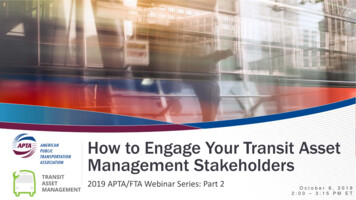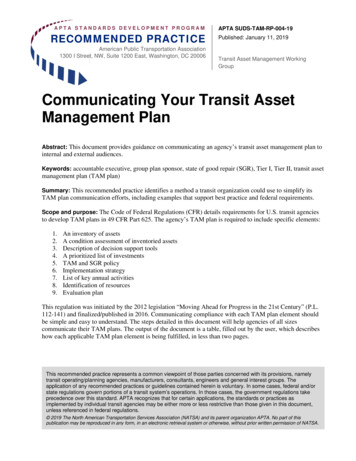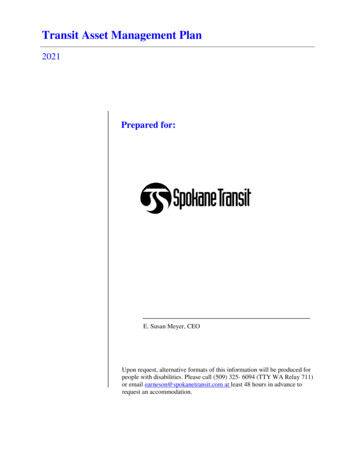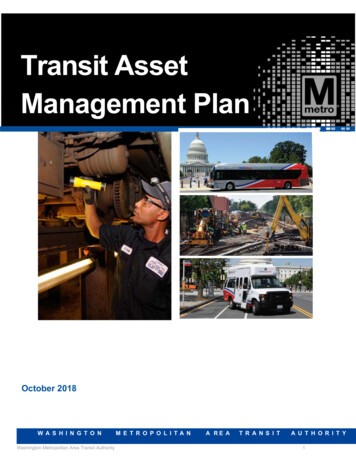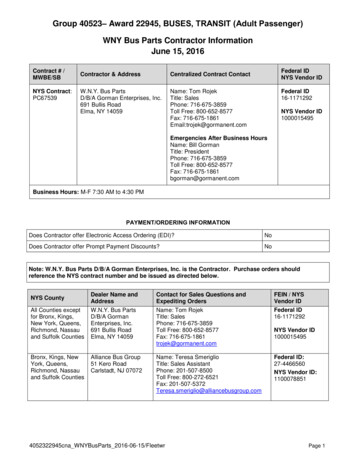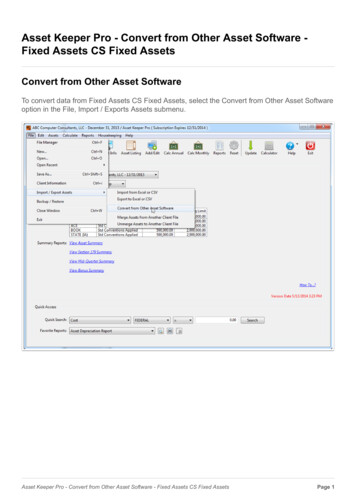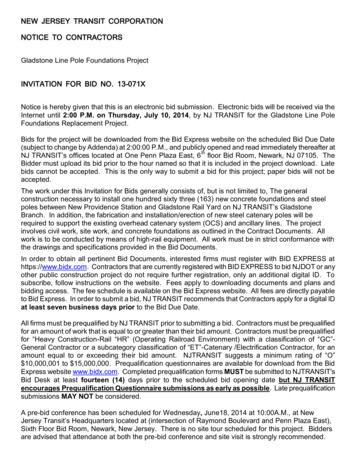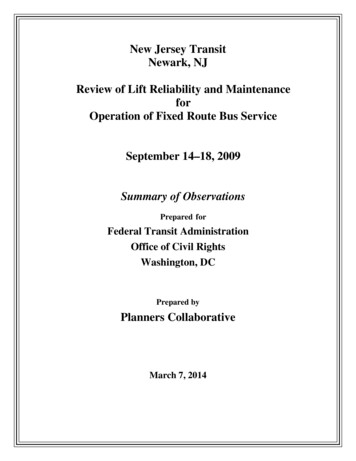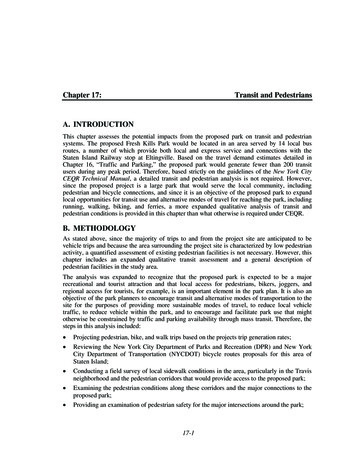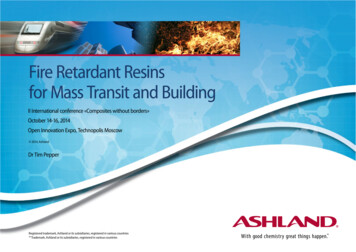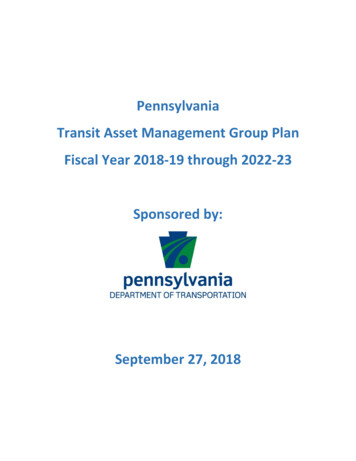
Transcription
PennsylvaniaTransit Asset Management Group PlanFiscal Year 2018‐19 through 2022‐23Sponsored by:September 27, 2018
Table of ContentsIntroduction . 3Pennsylvania Transit Asset Management (TAM) Group Plan Participants . 4Statewide Asset Management System. 5Asset Inventory and Condition Assessment . 6Asset Inventory . 6Condition Assessment . 6Asset Inventory and Condition Verification . 7Estimated Service Life (ESL) Standards . 7Asset Inventory and Condition Summary . 8Annual Performance Targets and Measures . 9Decision Support Tools . 10Investment Prioritization . 11Planning Partner Coordination . 11Recordkeeping and Reporting . 12Appendix A: Full Capital Asset InventoryAppendix B: Sample Facility Condition Assessment ChecklistsAppendix C: PennDOT ESL StandardsAppendix D: Sample Performance Based Planning Approach Acknowledgement Form2
IntroductionTransit Asset Management (TAM) is a systematic process that enables public transportation agencies toreach and maintain assets in a State‐of‐Good‐Repair (SGR). TAM accounts for the full life‐cycle of anasset used for public transportation service, from procurement through operations and maintenance tofinal disposition. Originally authorized by the Moving Ahead for Progress in the 21st Century Act (MAP‐21) and furthered by the Fixing America’s Surface Transportation Act (FAST ACT), the Federal TransitAdministration (FTA) developed the Transit Asset Management (TAM) model to: Monitor and manage public transportation assets Improve safety Increase reliability and performance Establish asset performance measuresIn July 2016, FTA issued a final rule requiring transit agencies to maintain and document minimum TAMstandards, policies, and procedures. The TAM rule applies to all recipients of Chapter 53 funds thateither own, operate, or manage federally‐funded capital assets used in providing public transportationservices. The TAM rule divides transit agencies into two categories based on size and mode:Tier I Operates Rail Fixed Guideway (§5337) OROperates over 100 vehicles across all fixed route modes OROperates over 100 vehicles in one non‐fixed route modeTier II Urban and Rural Public Transportation (§5307, §5310, and §5311 eligible) OR Operates up to and including 100 vehicles across all fixed route modes OR Operates up to and including 100 vehicles in one non‐fixed route modeIn Pennsylvania, the Pennsylvania Department of Transportation (PennDOT) is responsible for managingall public transportation programs for the Commonwealth. Through this responsibility, PennDOTmanages an annual public transportation program of 1.5 billion in state funds and more than 30million in direct federal funds. Pennsylvania is committed to ensuring that public transportation is safe,reliable, accessible, and affordable; and supports strong asset management as a key component toachieving these goals.The TAM rule requires states to participate and/or lead the development of a group plan for recipientsof Section 5311 and Section 5310 funding, and additionally allows other tier II providers to join a groupplan at their discretion. All required agencies (Section 5311 and 5310) and remaining tier II systemsexcept for Centre Area Transportation Authority (CATA), have elected to participate in the PennDOTGroup Plan. A listing of the agencies and their current accountable executive are identified on thefollowing page.3
Pennsylvania Transit Asset Management (TAM) Group Plan ParticipantsUrban and Rural Fixed Route AgenciesAltoona Metro Transit (Amtran)Area Transportation Authority of NC PA (ATA)Beaver County Transit Authority (BCTA)Borough of Mt. Carmel (LATS)Borough of Pottstown (PART)Butler Transit Authority (BTA)County of Lackawanna Transit Authority (COLTS)County of Lebanon Transit Authority (LT)Crawford Area Transit Authority (CATA)Cumberland‐Dauphin‐Harrisburg Transit Authority (CAT)Endless Mountains Transportation Authority (BEST)Erie Metropolitan Transit Authority (EMTA)Fayette County (FACT)Hazleton Public Transit (HPT)Indiana County Transit Authority (IndiGO)Lehigh and Northampton Transportation Authority (LANTA)Luzerne County Transportation Authority (LCTA)Mercer County Regional Council of Governments (SVSS)Mid‐County Transit Authority (TACT)Mid‐Mon Valley Transit Authority (MMVTA)Monroe County Transit Authority (MCTA)New Castle Area Transit Authority (NCATA)Schuylkill County (STS)Transit Authority of Warren County (TAWC)Williamsport Bureau of Transit (RVT)Washington County Transportation Authority (WCTA)Westmoreland County Transit Authority (WCTA)Accountable ExecutiveMandy MurphyColetta CoriosoKathy ClarkVictor GirardiKourtney HighTiffany FosnaughtRobert FiumeTerry SmithTim GeibelEric MaguireNicole FarrJeremy PetersonLori Groover‐SmithRalph SharpJohn KanyanBrendan CotterNorm GavlickKim DiCintioPatti Lynn JohnstonNancy BasileWalter QuadarellaJohn MisiudaDave BekiszWendy HollabaughNicole FarrSheila GombitaAlan BlahovecShared‐Ride only Agencies (5310 eligible)Allied Coordinated Transportation Services, Inc.Blair Senior ServicesBucks County TransportButler CountyCall A Ride ServicesCarbon CountyCentre CountyChester CountyClarion CountyCommunity Transit of Delaware CountyForest CountyGreene CountyHuntingdon‐Bedford‐Fulton AAAPike CountySomerset CountySTEP, Inc.Suburban Transit NetworkSusquehanna CountyWayne CountyVanessa CousinsDennis WisorJim RaymondJanine KennedyCindy SunderlandBrendan CotterDavid LomisonChristopher BurnsWayne BrosiusMarj BabiakBrenda McCannaRick BlakerMike WhysongRobert RuizDavid MrozowskiDaniel MerkMaria ChurchRonalyn LewisCarl Albright4
Statewide Asset Management SystemPennDOT has developed software to assist in the inventory and monitoring of assets, including conditionassessments and schedules of expected expenditures. This software, the Pennsylvania Capital PlanningTool (CPT), was created under a cooperative agreement between PennDOT and the Virginia Division ofRail and Public Transit (DRPT) and was funded through a FTA state‐of‐good‐repair award.Since 2016, PennDOT has used the Capital Planning Tool (CPT) to: Inventory all public transportation system assets; Collect relevant data on those assets; Predict asset replacement schedules based on Estimated Service Life (ESL) and asset condition; Create a four‐year capital program for each public transportation system to submit to theirregional planning organization for review and approval; Create an annual capital program for each public transportation system which becomes anagency’s individual capital application in PennDOT’s electronic granting system (dotGrants); Create an annual statewide public transportation capital program; Compare statewide capital needs to available funding; and Prioritize statewide capital program decisions based on meeting state‐of‐good‐repair (SGR)targets within available funding.5
Asset Inventory and Condition AssessmentAn accurate and comprehensive inventory of assets and a consistent condition assessment of theseassets is the most critical element of the TAM process. The following sections outline the requirementsfor achieving this.Asset InventoryAll Pennsylvania public transportation systems must maintain/update asset data in the CPT system. CPTstores crucial information about every asset type and maintains a complete history of the asset as itages. Transit agencies record changes in condition, usage, value, depreciation, etc. for the followingasset categories: Rolling Stock (Revenue Vehicles): Transit agency‐owned or leased Fixed Route & Paratransitvehicles, used to provide public transportation. Equipment: Tangible support property having a useful life of at least one year, including all non‐revenue/support vehicles. Facilities: A building or structure that is used in the provision of public transportation, includingadministrative and maintenance, and passenger and parking facilities.The asset inventory forms the basis of the group TAM plan and a current, complete inventory of allassets over 50,000 in value is identified in Appendix A. It is important to note that this list represents asnapshot in time, and the CPT will be continually updated as assets are added, retired, or as factschange. For the most current asset inventory, the CPT should be used.Condition AssessmentEach transit agency must update the age, mileage, and condition of their Rolling Stock and Equipmentassets at least annually. Additionally, transit agencies must document the condition of each transit‐related facility in the CPT. This annual update requirement exceeds the basic FTA requirement but isnecessary for PennDOT to properly plan long‐term capital funding. Each asset is rated as a whole integerusing FTA’s Transit Economic Requirements Model (TERM) scale:Excellent5.0 Brand new asset; no visible defects.Good4.0Asset showing minimal signs of wear; some (slightly) defective ordeteriorated component(s).Adequate3.0Asset has reached its mid‐life; some moderately defective ordeteriorated component(s).MarginalAsset reaching or just past the end of its useful life; increasing number2.0 of defective or deteriorated component(s) and increasing maintenanceneeds.Poor1.0Asset is past its useful life and needs immediate repair or replacement;may have critically damaged components(s).6
Agencies may reference the FTA Facility Condition Assessment Guidebook1 for detailed assessmentstandards. Sample checklists are included as Appendix B.Asset Inventory and Condition VerificationPennDOT staff, in coordination with transit agency management, will conduct periodic reviews of theCPT inventory and verify condition assessments though the following activities: Transit Agency Performance Reviews: A state‐required comprehensive review of agencymanagement and operations on five‐year cycle. Compliance Reviews: PennDOT conducts regular compliance reviews of public transportationgrantees, including those that receive §5310, §5311, and PennDOT Shared‐Ride Lottery funding.These reviews are conducted on a periodic basis that is generally every three years. Capital Program Field Reviews: PennDOT Capital Division regularly completes capital programfield reviews with grantees, where ongoing or recently closed projects are reviewed and capitalplans are discussed.PennDOT’s goal is to actively engage with each individual transit agency on an annual basis, andcomplete an in‐depth, on‐site review at least once every three (3) years to confirm the accuracy of CPTdata.Estimated Service Life (ESL) StandardsThe estimated life cycle or the acceptable period of use in service for a capital asset is determined byPennDOT Estimated Service Life (ESL) standards. An asset exceeding its ESL is a strong indicator that itmay not be in a state‐of‐good‐repair.For the purpose of the PennDOT TAM group plan, PennDOT has elected to not use FTA’s defined UsefulLife Benchmarks (ULB) and instead use the state recognized ESL Standards. The current ESL standardsare identified in Appendix C and available on the PennDOT 017.pdf7
Asset Inventory and Condition SummaryRolling Stock (Revenue Vehicles)Asset ClassAO‐AutomobileBU‐BusCU‐CutawayVN‐VanSV ‐ Sports Utility VehicleGrand TotalNumberAverage 85106,989119,40764,724154,283674565Number metor exceedingESL51884502973943% met orexceedingESL15%18%44%62%75%36%Number metor exceedingESL57% met orexceedingESL39%Equipment (Non‐Revenue Vehicles)AverageAgeAsset ClassNumberAverage MileageAutomobilesTrucks and other RubberTire VehiclesGrand itiesAsset ClassNumberAdministrative / Maintenance FacilitiesPassenger / Parking FacilitiesGrand Total344983AverageCondition onTERM Scale333Numberbelow 3.0 onTERM Scale91019% below3.0 onTERM Scale26%20%23%8
Annual Performance Targets and MeasuresPennDOT will annually update performance targets based on two primary elements: Prior year’s performance Anticipated/obligated funding levelsAs discussed in the investment prioritization section, PennDOT requires rolling stock and non‐revenuevehicles (equipment) to meet both age and mileage ESL standards prior to being replaced. While theidentified annual targets represent only age and condition in line with FTA guidelines, PennDOT willcontinue to apply age and mileage when making investment decisions.Performance MeasureAsset ClassRolling Stock (Revenue Vehicles)Age ‐ % of revenueAO‐Automobilevehicles within aBU‐Busparticular asset class thatCU‐Cutawayhave met or exceededVN‐Vantheir Estimated ServiceSV ‐ Sports Utility VehicleLife (ESL)Equipment (Non‐Revenue Vehicles)Age ‐ % of non‐Automobilesrevenue/service vehicleswithin a particular assetTrucks and other Rubber Tireclass that have met orVehiclesexceeded their ESLFacilitiesCondition ‐ % of facilitiesAdministrative /with a condition ratingMaintenance Facilitiesbelow 3.0 on the FTAPassenger / Parking FacilitiesTERM scaleCurrentPerformanceFY %100%100%26%26%20%20%9
Decision Support ToolsThe PennDOT BPT, in coordination with the PennDOT Planning and Program Center, the PennsylvaniaPublic Transportation Association through PennTRAIN (PA Rural Technical Assistance Program), and localtransit agencies will work to provide and regularly enhance decision support tools that aid in theimplementation of the TAM Plan. There are several primary decision support tools currently in placethat are foundational for the execution of TAM. They are: PennDOT Capital Planning Tool (CPT) – As documented above, the CPT allows PennDOT andtransit agencies to view current inventory, assess current and future needs, and plan for capitalreplacement and investment based on current and forecasted funding. The CPT includes theability to develop annual capital plans that, beginning with State Fiscal Year 2018‐19, will importdirectly into DotGrants, PennDOT’s online grants management system. Estimated Service Life (ESL) Standards – PennDOT has created ESL standards for most transitassets. The current ESL standards are identified in Appendix C. Agency Maintenance Plans – Agencies are required to have maintenance plans in place prior toreceiving funding from PennDOT. Maintenance plans are reviewed as a requirement in the§5310 application, reviewed during §5311 compliance reviews, and are reviewed and discussedduring the Transit Agency Performance reviews for all fixed route transit agencies. Capital Division Support – The PennDOT BPT Capital Division is charged with overseeing stateand federal grants and guiding grantees and subrecipients through the capital project process,from project development through design or specifications development, construction orprocurement, and project close‐out.In addition to the decision support tools identified above, PennDOT is in the process of implementing astatewide Fixed Route Intelligent Transportation Systems (FRITS) program. FRITS focuses on modernizingtransit technology and creating a standard platform throughout the Commonwealth. One key piece ofFRITS is real‐time vehicle health monitoring, which will allow agencies to identify problems before theyoccur on vehicles and prolong vehicle life, while also allowing agencies to better prioritize capital needs.10
Investment PrioritizationUsing established decision support tools, investment prioritization will occur annually as part of thecapital budgeting process. To prioritize investments at an agency level and at a statewide level, thefollowing basic actions take place: Update inventory in the CPT to include age, mileage, condition, and operational status Identify assets that are not in a state‐of‐good‐repair, using the following priority process:oVehicles that surpass age and mileage ESLoVehicles that surpass age or mileage ESL and are rated in poor condition or represent asafety hazardoFacilities that have a condition rating of less than 3 on the TERM Scale, with prioritygiven to facilities that are the lowest in the scale and represent a critical need tomaintain operational capacity Determine available funding based on federal and state funding sources Develop projects within the CPT Planner based upon funds availability Import CPT Planner into DotGrants for the execution of capital grantsThroughout the process, PennDOT reviews projects and works with agencies to approve and moveprojects forward through the grant process. A more detailed process is identified below according toeach organizations roles and responsibility.Planning Partner CoordinationCoordination between PennDOT, transit agencies, and the local planning partner—MetropolitanPlanning Organization (MPO) or Rural Planning Organization (RPO)— is a vital component of TAM.Furthermore, the final rule on metropolitan and statewide planning, published in the Federal Registeron May 27, 2016, requires MPOs to practice Performance Based Planning and Programming (PBPP).As documented in a “Dear Colleague” letter from FTA Region III dated August 17, 2018, “As part of theimplementation of the PBPP requirements, States, MPOs, and providers of public transportation mustjointly agree upon and develop specific written provisions for cooperatively developing and sharinginformation related to transportation performance data, the selection of performance targets, thereporting of performance targets, and the reporting of performance to be used in tracking progresstoward attainment of critical outcomes for the region of the MPO. These jointly written provisions canbe documented either as part of the metropolitan planning agreements required under 23 CFR 450.314or documented in some other means outside of the metropolitan planning agreements as determinedcooperatively by the MPOs, States, and providers of public transportation.”The Pennsylvania TAM Group Plan fulfills this requirement and encourages communication betweentransit agencies and their respective MPOs and RPOs. Using updated CPT data, PennDOT will provideannual reports on individual agency performance against established statewide targets to transitagencies for help in capital planning and in fulfilling the PBPP requirement. To do this, the followingprocess will take place:11
PennDOT will provide asset performance reports to transit agencies by August 31 of each yearthat measure performance against established targets for the previous fiscal year. Transit agencies will review content for accuracy and confi
Mid‐Mon Valley Transit Authority (MMVTA) Nancy Basile Monroe County Transit Authority (MCTA) Walter Quadarella New Castle Area Transit Authority (NCATA) John Misiuda Schuylkill County (STS) Dave Bekisz Transit Authority of Warren County (TAWC) Wendy Hollab
